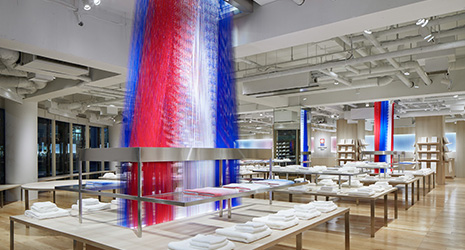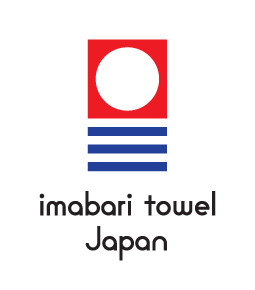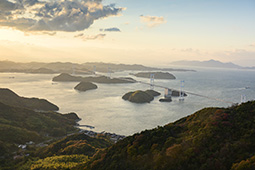INDEX
- English
- 日本語

The flagship imabari towel store in Imabari City - English
- 日本語

Imabari towels have excellent absorbency and a soft texture

The imabari brand logo with a design that combines the sun and ocean 
A worker prepares yarn for towel weaving 
A view from Imabari City over the Seto Inland Sea
September 2020
Imabari: The Home of Towels

Facing the Seto Inland Sea, Imabari City in Ehime Prefecture is the representative towel producing area of Japan. The towels, produced to original high standards of quality, are very popular both in Japan and abroad for their superior absorbency and softness.

Imabari City in Ehime Prefecture is the leading towel production area in Japan, with close to 200 related factories gathered here in addition to factories where towels are weaved, including twisted yarn factories, dye works, and more. Producing 11,000 tons annually, the city accounts for more than 50% of the share of domestically produced towels distributed in Japan. Among the towels produced here, awareness of the “imabari” towel regional brand is spreading not just in Japan but overseas, as well. These towels have a characteristic softness, smooth texture, and above all, superior absorbency.
Inoue Hiroki, president of the Imabari Towel Industrial Association, says, “Twelve original integrity standards of quality have been established for the imabari towel brand, including superior absorbency, durability and fade-free colors, but these towels became famous for the ‘Five Second Rule’ that shows the quality well.”
The “Five Second Rule” is a test to check the towel’s absorbency, and is a standard that verifies whether or not a 1 cm square piece cut from a towel begins to sink within five seconds of being floated on water. From this we can see that imabari towels have extremely superior absorbency, as the general Japan Industrial Standards (JIS) standard is 60 seconds.

The textile industry of Imabari City flourished from the early days of Japan’s modernization, for two main reasons. One is that the city faces the Seto Inland Sea, and its warm climate is suitable for growing cotton. The other is that marine transport to Osaka, a commercial center, was developed, making the distribution of goods easy. Towel production started here in 1894.
Production of towels from Imabari differs from ordinary towel production, traditionally using a technique known as “saki-zarashi saki-zome,” where yarn is refined and bleached and then dyed before weaving. Large amounts of water are required for this technique, which makes use of the original softness of the cotton, and this is made possible by the abundant underground water of the Soja River that flows through the city. The soft water with its low amounts of calcium, magnesium and other metal ions is gentle on the cotton yarn, allowing for a towel with a fine, soft texture.

At its height in the 1970s, about 500 towel manufacturers participated in the Imabari Towel Industrial Association, but from the 1990s, there were successive bankruptcies and withdrawals from the market following an increase in imports of cheap foreign-made towels, and today participating manufacturers have decreased to about 100. In 2006, “The Imabari Towel Recovery Project” was launched and successfully revitalized the “imabari towel” brand name, protecting this regional industry that was threatened with obsolescence. The project established that the value of the towels of Imabari lies in the quality of the towels itself. It also established the twelve original integrity standards of quality, including the Five Second Rule for absorbency, resistance and strength through use, and more. Products which met these standards came to be marked with a logo featuring a design that combines the sun and ocean, expressing a passion for towel manufacturing and the quality of the product.
A white towel bearing this logo was popular at MACEF, the International Home Show in Milan, Italy in January 2011, and at the Gift Show in Shanghai, August 2011, leading to the formation of the brand and an expansion of the domestic and international markets.

Today, many imabari towel products are aimed at the domestic market, but several manufacturers are developing exports to countries in North America, Europe and Asia. Inoue says, “I think the fact that the imabari towel brand is not a single company, but rather a regional brand made up of about 100 manufacturers, is a strength.” Consumers can choose their preferences in towel thickness, softness, length of terrycloth loops, and so on, as each manufacturer produces towels with their own characteristics.
Imabari City is the terminus and departure point for the Shimanami Kaido, an expressway that connects the main islands of Honshu and Shikoku via islands of the Seto Inland Sea, and the city has become famous as a place where many cyclists from within Japan and around the world gather to tour the magnificent cycling road above the sea. You will surely get the sense that imabari towels were developed from the beautiful nature here as you wipe away sweat while cycling along the expressway.

